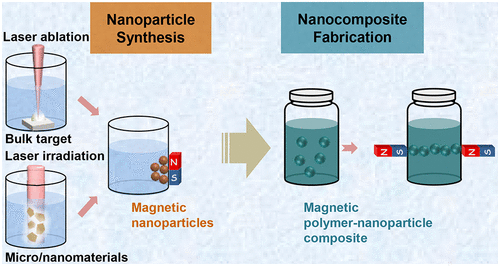当前位置:
X-MOL 学术
›
ACS Appl. Nano Mater.
›
论文详情
Our official English website, www.x-mol.net, welcomes your
feedback! (Note: you will need to create a separate account there.)
Laser Synthesis of Magnetic Nanoparticles in Liquids and Application in the Fabrication of Polymer–Nanoparticle Composites
ACS Applied Nano Materials ( IF 5.3 ) Pub Date : 2021-06-21 , DOI: 10.1021/acsanm.1c00715 Nikolaos G. Semaltianos 1 , Grzegorz Karczewski 2
ACS Applied Nano Materials ( IF 5.3 ) Pub Date : 2021-06-21 , DOI: 10.1021/acsanm.1c00715 Nikolaos G. Semaltianos 1 , Grzegorz Karczewski 2
Affiliation

|
The method of synthesis of nanoparticles in solution by laser ablation of a bulk target material immersed in a liquid does not require the use of any reducible chemical precursors or colloidal stabilizing agents. The resulting colloids are ultrapure, and in certain cases, the synthesized nanoparticles are surface-ligand-free (have “bare” surfaces). Furthermore, laser irradiation of micro/nanomaterials suspended in a liquid can lead to the synthesis of nanoparticles in solution with unique physicochemical properties. Interest in the application of the method for the synthesis of magnetic nanoparticles usually originates from the following facts: (i) Magnetic oxide or carbide nanoparticles can be directly synthesized by laser ablating the corresponding elemental target material in the appropriate liquid, (ii) magnetoplasmonic bimetallic alloy nanoparticles (e.g., FeAu), even composed of elements that are immiscible at any temperature in the solid or liquid phase (e.g., FeAg, CoAg), can be synthesized by ablating nonalloyed bimetallic targets, (iii) under the application of an external magnetic field, nanoparticle chains and strands can be fabricated that are characterized by a high packing density of the nanoparticles that together with their “bare” surfaces result in the strands having both a high aspect ratio and electrical conductivity, (iv) magnetic nanostructures that consist of nanoparticles and nanomaterials with different morphologies or properties can be fabricated, and (v) nanoparticles of intrinsically nonmagnetic oxides exhibiting the so-called d0 ferromagnetism can be synthesized. By using laser-synthesized-in-liquid magnetic nanoparticles in the fabrication of polymer–nanoparticle composites (magnetic nanocomposites), the presence of any chemical reaction byproducts in the nanocomposite is avoided. The nanoparticles form direct chemical bonds with the polymer matrix. Nanoparticle strands formed in the nanocomposite provide it with a high electrical conductivity while preserving its optical transparency. This Review is focused on the synthesis of magnetic nanoparticles in solution by laser ablation of a bulk target material immersed in a liquid or laser irradiation of micro/nanoparticles or micro/nanomaterials suspended in a liquid and the fabrication of magnetic nanocomposites using these nanoparticles.
中文翻译:

液体中磁性纳米粒子的激光合成及其在聚合物-纳米粒子复合材料制备中的应用
通过激光烧蚀浸入液体中的大块目标材料在溶液中合成纳米颗粒的方法不需要使用任何可还原的化学前体或胶体稳定剂。得到的胶体是超纯的,在某些情况下,合成的纳米粒子是无表面配体的(具有“裸露”表面)。此外,悬浮在液体中的微/纳米材料的激光照射可导致在溶液中合成具有独特物理化学性质的纳米粒子。对磁性纳米粒子合成方法应用的兴趣通常源于以下事实:(i) 磁性氧化物或碳化物纳米粒子可以通过在适当的液体中激光烧蚀相应的元素目标材料来直接合成,可以合成0铁磁性。通过在聚合物-纳米颗粒复合材料(磁性纳米复合材料)的制造中使用激光合成的液体磁性纳米颗粒,避免了纳米复合材料中任何化学反应副产物的存在。纳米颗粒与聚合物基质形成直接的化学键。在纳米复合材料中形成的纳米颗粒链为其提供高导电性,同时保持其光学透明度。本综述的重点是通过激光烧蚀浸入液体中的大块目标材料或激光照射悬浮在液体中的微/纳米颗粒或微/纳米材料来合成溶液中的磁性纳米颗粒,以及使用这些纳米颗粒制造磁性纳米复合材料。
更新日期:2021-07-23
中文翻译:

液体中磁性纳米粒子的激光合成及其在聚合物-纳米粒子复合材料制备中的应用
通过激光烧蚀浸入液体中的大块目标材料在溶液中合成纳米颗粒的方法不需要使用任何可还原的化学前体或胶体稳定剂。得到的胶体是超纯的,在某些情况下,合成的纳米粒子是无表面配体的(具有“裸露”表面)。此外,悬浮在液体中的微/纳米材料的激光照射可导致在溶液中合成具有独特物理化学性质的纳米粒子。对磁性纳米粒子合成方法应用的兴趣通常源于以下事实:(i) 磁性氧化物或碳化物纳米粒子可以通过在适当的液体中激光烧蚀相应的元素目标材料来直接合成,可以合成0铁磁性。通过在聚合物-纳米颗粒复合材料(磁性纳米复合材料)的制造中使用激光合成的液体磁性纳米颗粒,避免了纳米复合材料中任何化学反应副产物的存在。纳米颗粒与聚合物基质形成直接的化学键。在纳米复合材料中形成的纳米颗粒链为其提供高导电性,同时保持其光学透明度。本综述的重点是通过激光烧蚀浸入液体中的大块目标材料或激光照射悬浮在液体中的微/纳米颗粒或微/纳米材料来合成溶液中的磁性纳米颗粒,以及使用这些纳米颗粒制造磁性纳米复合材料。






























 京公网安备 11010802027423号
京公网安备 11010802027423号